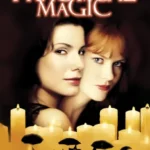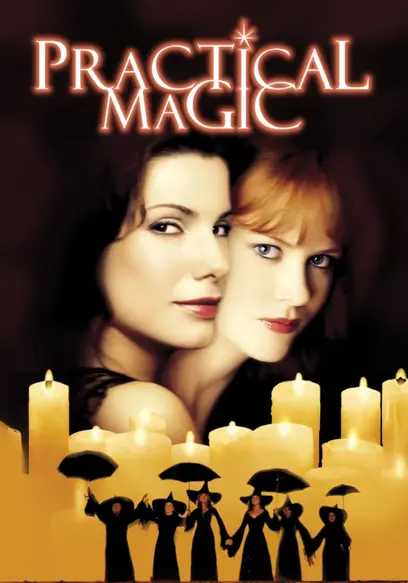 Gracing the late 1990s with its blend of romance, witchcraft, and suburban melodrama, Practical Magic (1998) is one of those movies that elicits strong reactions: some viewers love its campy charm, while others groan at its tonal inconsistencies. Directed by Griffin Dunne and starring Sandra Bullock and Nicole Kidman as the Owens sisters, the film straddles multiple genres, aiming to be a romantic fantasy, a family drama, and a supernatural thriller all at once. The result is a film that is, in equal measure, enchanting, frustrating, amusing, and occasionally bewildering—truly an “awesome terrible” experience.
Gracing the late 1990s with its blend of romance, witchcraft, and suburban melodrama, Practical Magic (1998) is one of those movies that elicits strong reactions: some viewers love its campy charm, while others groan at its tonal inconsistencies. Directed by Griffin Dunne and starring Sandra Bullock and Nicole Kidman as the Owens sisters, the film straddles multiple genres, aiming to be a romantic fantasy, a family drama, and a supernatural thriller all at once. The result is a film that is, in equal measure, enchanting, frustrating, amusing, and occasionally bewildering—truly an “awesome terrible” experience.
The film follows sisters Sally (Sandra Bullock) and Gillian Owens (Nicole Kidman), witches in a small Massachusetts town who have been cursed for generations: any man they fall in love with is doomed to die tragically. This curse frames the story, driving both the plot and the sisters’ emotional arcs. Sally is practical, cautious, and wary of men, while Gillian is free-spirited, impulsive, and reckless. When Gillian’s romantic entanglements bring danger to their doorstep, the sisters must confront the family curse and harness their magical powers to protect themselves and those they love.
From the outset, Practical Magic establishes a whimsical, slightly gothic aesthetic. Dunne and cinematographer Michael Chapman create a visually lush world where coastal New England settings, cozy Victorian houses, and mystical moonlit gardens coexist. The film’s visual palette emphasizes warm, saturated colors that enhance its storybook quality, while carefully placed shadows and candlelit interiors evoke both romance and supernatural tension. The production design, combined with costume choices that distinguish Sally’s practicality from Gillian’s flamboyance, gives the film an instantly recognizable, stylish identity.
Sandra Bullock and Nicole Kidman anchor the film with charisma and chemistry. Bullock’s Sally is relatable and grounded, offering a lens through which audiences can experience the magical chaos of their lives. Her timing—both comedic and dramatic—keeps the film from descending entirely into melodrama. Kidman’s Gillian is a whirlwind of impulsivity and charm, her performance balancing mischievousness and vulnerability. Together, the sisters provide an emotional core that carries the film, even when narrative or tonal inconsistencies threaten to derail it. Their sibling bond feels authentic, with moments of tenderness, bickering, and shared mischief that give the story heart amid the magic and mayhem.
Where Practical Magic truly earns its “awesome” label is in its blend of romance, supernatural elements, and humor. The film tackles the curse plot with a playful inventiveness, turning the classic “star-crossed lovers” trope into a framework for witty, often dramatic storytelling. The magic system, while not deeply explored in a technical sense, is visually inventive and entertaining. Spells, potions, and magical interventions are used both to resolve plot points and as comic devices, lending a sense of whimsy to scenes that might otherwise be dark or tense. The film also benefits from a score by Michael Nyman, whose ethereal compositions heighten both romantic and mystical sequences.
Yet, as much as it is visually enchanting, Practical Magic is undeniably “terrible” in several ways. Its tone fluctuates wildly: one moment, it is a heartfelt family drama, the next, a fantastical thriller, and then a light-hearted romantic comedy. These shifts can be jarring, leaving viewers unsure of how to interpret the story. Romantic beats are often predictable, and the suspense sequences sometimes feel like they belong in a different movie entirely. The combination of supernatural horror, melodrama, and quirky humor occasionally clashes, creating an experience that is as uneven as it is entertaining.
The supporting cast contributes to both the strengths and weaknesses of the film. Stockard Channing and Dianne Wiest as the Owens matriarchs provide gravitas, grounding the sisters’ story in family history and tradition. Their performances underscore the generational consequences of the family curse and the weight of inherited responsibility. However, secondary characters like the romantic interests, particularly James (Aidan Quinn), are occasionally underdeveloped, serving mostly as catalysts for plot progression rather than fully realized individuals. This imbalance can make the film’s romantic subplots feel contrived, though the actors’ charisma often compensates for narrative shortcomings.
Dialogue and scripting, penned by Akiva Goldsman, are similarly uneven. The script mixes modern wit, gothic melodrama, and occasional self-aware humor, sometimes in the same scene. While this creates moments of charm and levity, it also contributes to tonal whiplash. Lines meant to be witty or romantic occasionally read as stilted, and exposition-heavy sequences can drag, interrupting the flow of the narrative. Still, the dialogue’s quirks often work in the film’s favor, enhancing its campy, fantastical feel and contributing to its enduring cult status.
The romance element is a significant part of the film’s appeal, though it is also a source of frustration. Love interests appear and disappear with minimal narrative setup, and the curse plot, while thematically rich, sometimes reduces romance to a plot device rather than an emotional journey. However, when the film succeeds—especially in scenes where Bullock and Quinn share intimate moments or where Kidman’s impulsivity drives romantic tension—it is genuinely engaging and fun to watch. The balance between doomed love, magical hijinks, and family loyalty creates a story that is occasionally moving, occasionally absurd, and consistently entertaining.
One of the most memorable aspects of Practical Magic is its use of witchcraft as both plot device and metaphor. The magic is visually playful, often whimsical, and deeply tied to the sisters’ personalities. Sally’s cautious, practical magic reflects her temperament, while Gillian’s chaotic spells mirror her reckless nature. This distinction allows the film to explore themes of control, consequence, and personal responsibility. The supernatural elements also serve as metaphors for adolescence, love, and familial bonds, grounding the film’s fantastical components in emotional reality.
Despite these strengths, the film suffers from pacing issues. Some sequences drag, particularly during exposition-heavy explanations of the curse or backstory, while climactic confrontations occasionally feel rushed. The film’s uneven rhythm contributes to its “awesome terrible” status: moments of genuine tension, humor, and romance are interspersed with narrative lulls that test viewer patience. Still, the highs are sufficiently entertaining to make enduring engagement worthwhile.
Costume design and set decoration further enhance the film’s charm. The Owens home, brimming with eclectic antiques, magical paraphernalia, and cozy Gothic touches, becomes a character in its own right. It visually represents the family’s history, the weight of the curse, and the whimsical tone of the film. Costumes similarly reflect character and mood, distinguishing the sisters from their suburban surroundings while emphasizing their unique personalities. These details contribute to the film’s immersive, fantastical quality, giving it a visual richness that remains memorable decades later.
The film’s climax blends horror, romance, and magic in a way that is both thrilling and absurd. Spells, confrontations, and revelations pile up rapidly, creating a chaotic narrative peak that is equal parts exciting and melodramatic. The special effects, while occasionally dated, are inventive, enhancing both suspense and comedy. While the resolution may stretch credulity, it is consistent with the film’s playful, whimsical tone. The ending ultimately reinforces the themes of sisterhood, love, and personal agency, giving audiences a sense of closure even amid the chaos.
Humor is sprinkled throughout the film, sometimes subtly and sometimes overtly. The Owens sisters’ interactions, magical mishaps, and sarcastic asides contribute levity to what could otherwise be a dark or overly sentimental story. This humor is uneven, occasionally clashing with more dramatic sequences, but it is largely endearing, helping to maintain viewer engagement and contributing to the film’s “awesome” charm.
Ultimately, Practical Magic is a film of contradictions. It is visually stunning yet narratively uneven, romantic yet melodramatic, humorous yet occasionally heavy-handed. Its flaws are inseparable from its appeal: the tonal shifts, pacing issues, and occasional narrative absurdities contribute to a viewing experience that is as entertaining as it is unpredictable. It is a film that inspires affection, laughter, and frustration in equal measure.
The sisters’ relationship remains the emotional heart of the film. Bullock and Kidman’s chemistry grounds the story, ensuring that even the most over-the-top magical sequences resonate emotionally. The narrative, despite its flaws, is ultimately about family, love, and personal choice, themes that give the film depth beyond its visual spectacle. The mixture of witchcraft, romance, and suburban drama allows the movie to explore these themes in a fun, imaginative, and occasionally ridiculous way.
In the end, Practical Magic is perfectly imperfect. It is a movie that invites viewers to embrace both its charm and its absurdities, reveling in the spectacle, romance, and supernatural antics while laughing at its inconsistencies. Its combination of stylistic flair, thematic ambition, and uneven execution makes it a quintessential “awesome terrible” movie: flawed, ambitious, and unforgettable.
For those willing to accept its contradictions and indulge in its campy, magical charm, Practical Magic offers a cinematic experience that is both entertaining and strangely comforting. It is a film that charms, frustrates, and delights simultaneously, leaving viewers with a sense of wonder, amusement, and nostalgia. Its imperfections are part of its magic, and its audacity ensures it remains memorable decades after its release.
This post has already been read 31 times!





